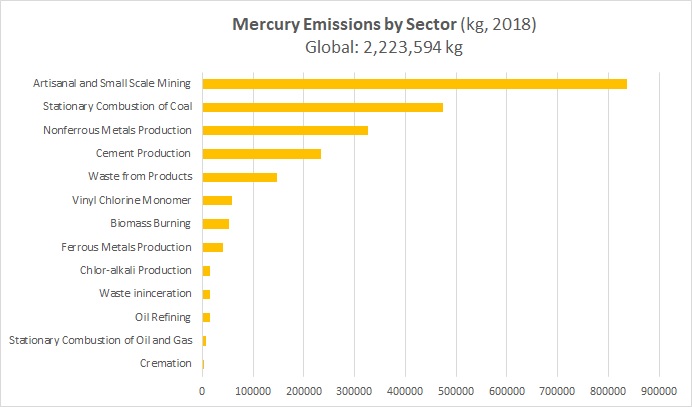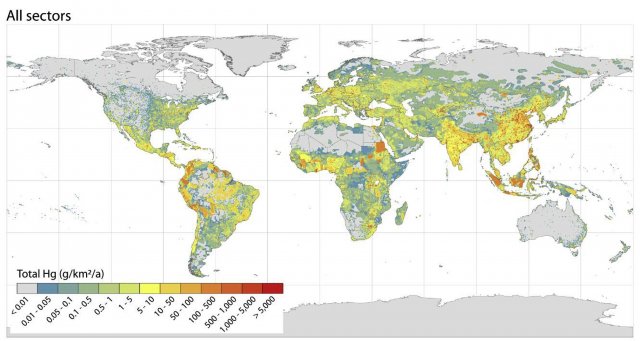Mercury Emissions: The Global Context
Mercury emissions know no national or continental boundaries. Mercury emitted into the air can travel thousands of miles in the atmosphere before it is eventually deposited back to the earth in rainfall or in dry gaseous form.
How does mercury threaten our health?
Exposure to mercury threatens our health, with many often irreversible toxic effects. Developing fetuses and young children are most at risk. Mercury pollution also harms wildlife and ecosystems.
Mercury occurs naturally in the earth’s crust, but human activities, such as mining and fossil fuel combustion, have led to widespread global mercury pollution. Mercury emitted into the air eventually settles into water or onto land where it can be washed into water. Once deposited, certain microorganisms can change it into methylmercury, a highly toxic form that builds up in fish, shellfish and animals that eat fish. Most human exposure to mercury is from eating fish and shellfish contaminated with methylmercury, both in the United States and worldwide.
Almost all people in the world have at least trace amounts of methylmercury in their tissues, reflecting its pervasive presence in the environment. Some communities eat significantly more quantities of fish than the general population, and thus may be exposed to much greater mercury contamination than the general population. It is estimated that more than 75,000 newborns in the United States each year may have increased risk of learning disabilities associated with in-utero exposure to methylmercury.
- Learn more about the toxic effects of mercury.
- Learn more about mercury exposure in the United States.
Types of Sources
Natural sources of mercury include volcanic eruptions and emissions from the ocean. Anthropogenic (human-caused) emissions include mercury that is released from fuels or raw materials, or from uses in products or industrial processes.
Some of the mercury circulating through today's environment was released years ago. Land, water, and other surfaces can repeatedly re-emit mercury into the atmosphere after its initial release into the environment. We know that anthropogenic emissions continue to add significantly to the global pool of mercury.
Globally, artisanal and small-scale gold mining (ASGM) is the largest source of anthropogenic mercury emissions (37.7%), followed by stationary combustion of coal (21%). Other large sources of emissions are non-ferrous metals production (15%) and cement production (11%). (United Nations Environment Programme, Global Mercury Assessment, 2018)

| Source | Amount (kg) |
|---|---|
| Artisanal and Small Scale Mining | 837,658 |
| Stationary Combustion of Coal | 473,777 |
| Nonferrous Metals Production | 326,657 |
| Cement Production | 233,168 |
| Waste from Products | 146,938 |
| Vinyl Chlorine Monomer | 58,268 |
| Biomass Burning | 51,860 |
| Ferrous Metals Production | 39,903 |
| Chlor-alkali Production | 15,146 |
| Waste ininceration | 14,944 |
| Oil Refining | 14,377 |
| Stationary Combustion of Oil and Gas | 7,130 |
| Cremation | 3,768 |
Worldwide Emissions
How much mercury is emitted worldwide each year? Estimates of annual global mercury emissions from anthropogenic sources are approximately 2220 metric tons per year. These estimates include mercury that is re-emitted. The world map below provides information about the worldwide distribution of anthropogenic mercury emissions.
Source: Development and application of an updated geospatial distribution model for gridding 2015 global mercury emissions (Figure 3) as developed for the 2018 Global Mercury Assessment and its Technical Background Report.
Learn More
- For more information on regulatory and policy measures that EPA is taken to reduce mercury pollution, see the EPA Mercury Portal.
- Learn about EPA's International Actions Reducing Mercury Emissions and Use.
Contacts
For additional information on EPA's work with mercury, contact:
Rodges Ankrah
U.S. Environmental Protection Agency
Office of International and Tribal Affairs (2670R)
1200 Pennsylvania Ave., NW
Washington, DC 20460
E-mail: ankrah.rodges@epa.gov
(202) 564-0280

